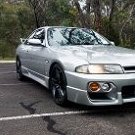R33 S2 Rb25det Noise From Timing Belt Cover
Announcements
-
Similar Content
-
Latest Posts
-
I mean I can be OCD'y but this is really over the top. At that point why not just run a full wideband fuel controller? Especially if you run 3 widebands. The system works pretty well, which is trimming low load stuff to be within a few percent of the base map. Pre-engine _change_ the base map was only 1-2% off, depending on ambient temp, elevation, etc. Under load the LS is really very straightforward to tune, enough that a wideband closed loop would be overkill. If I really cared (and I hope I don't) I can always just go back to the MAF system the car actually came with. Which does all those nice calculations for me (temp, altitude, etc), now that you can buy 102mm MAF's that do not cause restrictions.
-
Good afternoon Team , just a quick update on performance mods Current Mods list (Installed) HKS - Power Editor (Came with the car) looks to be some kind of boost controller RV37 Skyline 400R (SKYLINE) | FUJITSUBO - Cat Back RV37 Skyline 400R (SKYLINE) | FUJITSUBO - Front Pipe AMS - INFINITI Q50/Q60 RED ALPHA COLD AIR INTAKE KIT AMS - Performance Heat Exchanger Intercooler Not Yet AMS Alpha Performance Full Race Down Pipes - to be installed in May
-
I'd be installing 2x widebands and using the NB simulation outputs to the ECU.
-
Nah, it's different across different engines and as the years went on. R32 era RB20, and hence also RB26, the TPS SWITCH is the idle command. The variable resistor is only for the TCU, as you say. On R33 era RB25 and onwards (but probably not RB26, as they still used the same basic ECU from the R32 era), the idle command is a voltage output of close to 0.45V from the variable resistor.
-
It's actually one of the worst bits of Nissan nomenclature (also compounded by wiring diagrams when the TCU is incorporated in ECU, or, ECU has a passthru to a standalone TCU).... the gripe ~ they call it the TPS, but with an A/T it's actually a combined unit ...TPS (throttle position switch) + TPS (throttle position sensor).... ..by the looks of it (and considering car is A/T) you have this unit... https://www.amayama.com/en/part/nissan/2262002u11 The connector on the flying lead coming out of the unit, is the TPS (throttle position sensor) ...only the TCU reads this. The connector on the unit body, is the TPS (throttle position switch) ...ECU reads this. It has 3 possible values -- throttle closed (idle control contact), open (both contacts open, ECU controls engine...'run' mode), and WOT (full throttle contact closed, ECU changes mapping). When the throttle is closed (idle control contact), this activates what the patent describes as the 'anti stall system' ~ this has the ECU keep the engine at idling speed, regardless of additional load/variances (alternator load mostly, along with engine temp), and drives the IACV solenoid with PWM signal to adjust the idle air admittance to do this. This is actually a specific ECCS software mode, that only gets utilized when the idle control contact is closed. When you rotate the TPS unit as shown, you're opening the idle control contact, which puts ECCS into 'run' mode (no idle control), which obviously is a non-sequitur without the engine started/running ; if the buzzing is coming from the IACV solenoid, then likely ECCS is freaking out, and trying to raise engine rpm 'any way it can'...so it's likely pulling the valve wide open....this is prolly what's going on there. The signal from the connector on the flying lead coming out of the unit (for the TCU), should be around 0.4volts with the throttle closed (idle position) ~ although this does effect low throttle shift points if set wrong, the primary purpose here is to tell TCU engine is at idle (no throttle demand), and in response lower the A/T line pressure ... this is often described as how much 'creep' you get with shifter in D at idle. The way the TPS unit is setup (physically), ensures the idle control contact closes with a high margin on the TPSensor signal wire, so you can rotate the unit on the adjustment slots, to achieve 0.4v whilst knowing the idle control contact is definitely closed. The IACV solenoid is powered by battery voltage via a fuse, and ground switched (PWM) by the ECU. When I check them, I typically remove the harness plug, feed the solenoid battery voltage and switch it to ground via a 5watt bulb test probe ; thing should click wide open, and idle rpm should increase... ...that said though, if it starts & idles with the TPS unit disconnected, and it still stalls when it gets up to operating temperature, it won't be the IACV because it's unused, which would infer something else is winking out...
-





Recommended Posts
Create an account or sign in to comment
You need to be a member in order to leave a comment
Create an account
Sign up for a new account in our community. It's easy!
Register a new accountSign in
Already have an account? Sign in here.
Sign In Now